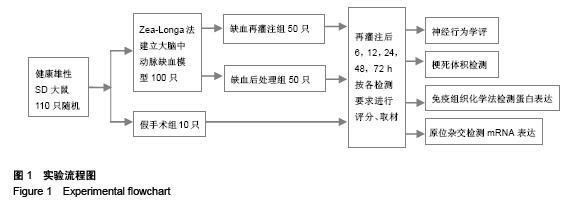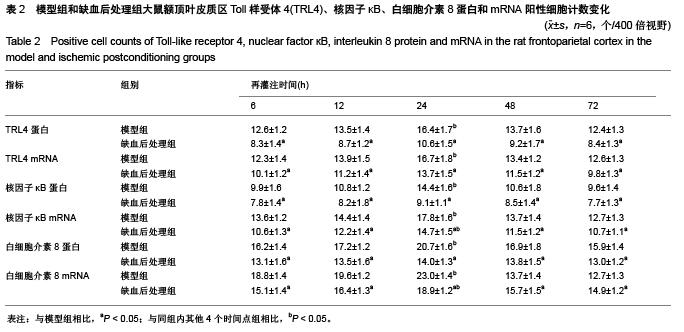| [1] Zhao ZQ, Corvera JS, Halkos ME, et al. Inhibition of myocardial injury by ischemic postconditioning during reperfusion: comparison with ischemic preconditioning. Am J Physiol Heart Circ Physiol. 2003;285(2):H579-H588.
[2] Zhao H, Sapolsky RM, Steinberg GK. Interrupting reperfusion as a stroke therapy: ischemic postconditioning reduces infarct size after focal ischemia in rats. J Cereb Blood Flow Metab. 2006;26(9):1114-1121.
[3] 王岭,孙丽,高焕民,等.胡黄连苷II对大鼠脑缺血再灌注损伤后炎症反应影响[J].青岛大学医学院学报,2011,47(1):62-64.
[4] Hamanaka J, Hara H. Involvement of Toll-like receptors in ischemia-induced neuronal damage. Cent Nerv Syst Agents Med Chem. 2011;11(2):107-113.
[5] Li XQ, Wang J, Fang B, et al. Intrathecal antagonism of microglial TLR4 reduces inflammatory damage to blood-spinal cord barrier following ischemia/reperfusion injury in rats. Mol Brain. 2014;7:28.
[6] Pradillo JM, Fernández-López D, García-Yébenes I, et al. Toll-like receptor 4 is Involved in neuroprotection afforded by ischemic preconditioning. Neurochem. 2009;109(1):287-294.
[7] Liang J, Luan Y, Lu B, et al. Protection of ischemic postconditioning against neuronal apoptosis induced by transient focal ischemia is associated with attenuation of NF-κB/p65 activation. PLoS One. 2014;9(5):e96734.
[8] Wang Q, Tang XN, Yenari MA. The inflammatory response in stroke. J Neuroimmunol. 2007;184(1-2):53-68.
[9] Feng R, Li S, Li F. Toll-like receptor 4 is involved in ischemic tolerance of postconditioning in hippocampus of tree shrews to thrombotic cerebral ischemia. Brain Res. 2011;1384: 118-127.
[10] Gao Y, Fang X, Sun H. Toll-like receptor 4-mediated myeloid differentiation factor 88-dependent signaling pathway is activated by cerebral ischemia-reperfusion in hippocampal CA1 region in mice. Biol Pharm Bull. 2009;32(10):1665-1671.
[11] Bhattacharyya S, Gill R, Chen ML, et al. Toll-like receptor 4 mediates induction of the Bcl10-NFkappaB-interleukin-8 inflammatory pathway by carrageenan in human intestinal epithelial cells. J Biol Chem. 2008;283(16):10550-10558.
[12] Kostulas N, Kivisäkk P, Huang Y, et al. Ischemic stroke is associated with a systemic increase of blood mononuclear cells expressing interleukin-8 mRNA. Stroke. 1998;29(2): 462-466.
[13] 中华人民共和国科学技术部.关于善待实验动物的指导性意见.2006.
[14] 吕敬雷,王国峰,王鹏,等.缺血后处理下调脑缺血再灌注大鼠白细胞介素-1β和肿瘤坏死因子-α表达[J].国际脑血管病杂志, 2012, 20(2):135-141.
[15] Logga EZ, Weinstein PR, Carson S, et a1. Reversible middle cerebral artery occlusion without craniectomy in rats. Stroke. 1989;20(1):84-91.
[16] Menzies SA, Hoff JT, Betz A. Middle cerebral artery occlusion in rats: a neurological and pathological evaluation of a reproducible model. Neurosurgery. 1992;31(1):100-106.
[17] 谢惠芳,徐如祥,陈中灿.线栓法制作大鼠局灶性脑缺血再灌注损伤模型的改进[J].中华神经医学杂志,2007,6(4):340-342.
[18] Wang JY, Shen J, Gao Q, et al. Ischemic postconditioning protects against global cerebral ischemia/reperfusion-induced injury in rats. Stroke. 2008;39(3):983-990.
[19] Ren HC, Gao XW, Niu G, et al. Delayed Postconditioning Protects against Focal Ischemic Brain Injury in Rats. PLoS One. 2008;3(12):e3851.
[20] Wang JK, Wu HF, Zhou H, et al. Postconditioning with sevoflurane protects against focal cerebral ischemia and reperfusion injury involving mitochondrial ATP-dependent potassium channel and mitochondrial permeability transition pore. Neurol Res. 2015;37(1):77-83.
[21] Yang F, Zhang X, Sun Y, et al. Ischemic postconditioning decreases cerebral edema and brain blood barrier disruption caused by relief of carotid stenosis in a rat model of cerebral hypoperfusion. PLoS One. 2013;8(2):e57869.
[22] 孙静,董海龙,栾琪,等.缺血后处理减轻大鼠局灶性脑缺血再灌注损伤最佳方案[J].第四军医大学学报,2007,28(24):2214-2216.
[23] He Y, ZHou AL, Jiang W.Toll-like receptor 4-mediated signaling participates in apoptosis of hippocampal neurons. Neural Regen Res. 2013;8 (29): 2744-2753
[24] Li XQ, Wang J, Fang B, et al. Intrathecal antagonism of microglial TLR4 reduces inflammatory damage to blood-spinal cord barrier following ischemia/reperfusion injury in rats. Mol Brain. 2014;7:28.
[25] Hu YE,Mao JH,Zhang Y,et al.Role of Toll-like receptor 4 in inflammatory reactions of hippocampal neurons.Neural Regen Res. 2013;8 (16): 1465-1472.
[26] Cao CX, Yang QW, Lv FL. Reduced cerebralischemia- reperfusion injury in Toll-like receptor 4 deficient mice. Biochem Biophys Res. 2007;353(2):509-514.
[27] Hyakkoku K, Hamanaka J, Tsuruma K, et al. Toll-like receptor 4 (TLR4), but not TLR3 or TLR9, knock-out mice have neuroprotective effects against focal cerebral ischemia. Neuroscience. 2010;171(1):258-267.
[28] 冯蕊,李树清.缺血后适应对脑缺血树鼩海马TLR4表达的影响[J].中国病理生理杂志,2011,27(6):1048-1052.
[29] Wasserman JK, Yang H, Schlichter LC. Glial responses,neuron death and lesion resolution after intracerebral hemorrhage in young vs aged rats. Eur J Neurosci. 2008;28(7):1316-1328.
[30] Zwagerman N, Plumlee C, Guthikonda M, et al. Toll-like receptor-4 and cytokine cascade in stroke after exercise. Neurol Res. 2010;32(2):123-126.
[31] Ding Y, Clark JC. Cerebrovascular injury in stroke. Neurol Res. 2006;28(1):3-10.
[32] Frangogiannis NG. Chemokines in ischemia and reperfusion. Thromb Haemost. 2007;97(5):738-747.
[33] Owens T, Babcock AA, Millward JM, et al. Cytokine and chemokine inter-regulation in the inflamed or injured CNS. Brain Res Rev. 2005;48(2):178-184.
[34] Masdumoto T, Yokoi K, Mukaida N, et al. Pivotal role of interleukin-8 in the acute respiratory distress syndrome and cerebral reperfusion injury. J Leukoc Boil. 1997;62(11): 581-587.
[35] Zeng L, Wang Y, Liu J, et al. Pro-inflammatory cytokine network in peripheral inflammation response to cerebral ischemia. Neurosci Lett. 2013;548:4-9.
[36] Huber AR, Kunkel SL, Todd RF, et al. Regulation of transendothelial neutrophil migration by endogenous interleukin-8. Science. 1991;254(5028):99-102. |


.jpg)

.jpg)

.jpg)